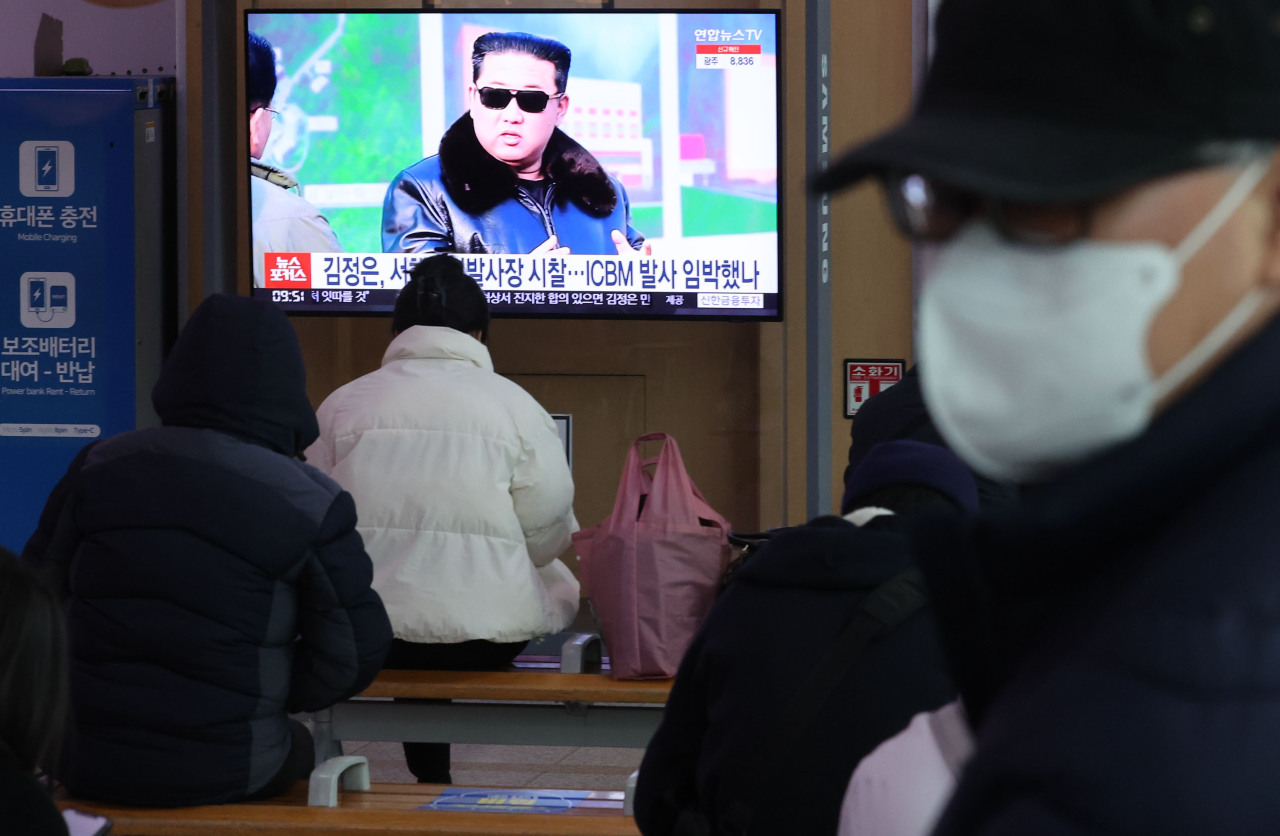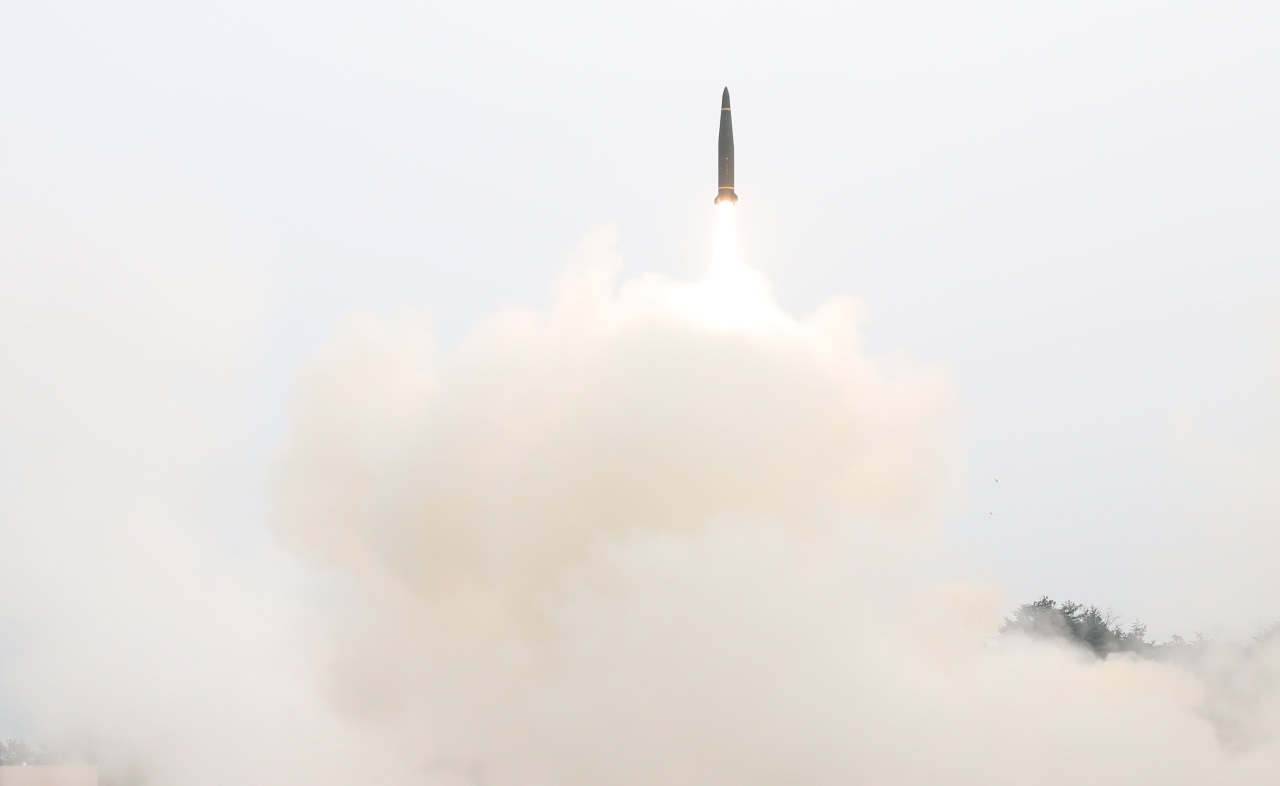 |
Passersby watch a TV report of North Korea’s missile launch at Seoul Station (File Photo - Yonhap) |
North Korea on Thursday fired an intercontinental ballistic missile after more than a four-year hiatus, breaking its self-imposed moratorium on ICBM and nuclear tests.
Pyongyang launched an ICBM-class projectile that flew more than one hour and 10 minutes toward the East Sea at 2:34 p.m. from the Sunan area of the capital city Pyongyang.
The ICBM flew around 1,080 kilometers at an altitude of 6200 km or higher, the Joint Chiefs of Staff said, adding that the missile is presumed to have been fired at a high angle and with a lofted trajectory.
Japan’s Deputy Defense Minister Makoto Oniki said North Korea may be testing a new model of an ICBM. But the JCS said South Korean and US intelligence authorities are still analyzing further specifications.
In response to the ICBM launch, the South Korean military forces jointly launched different types of missiles along the eastern coast from 4:25 p.m to ”demonstrate the determination and capability to immediately respond and punish” North Korea’s launches, the JCS said.
A Hyunmoo II surface-to-surface missile, a Haeseong II ship-launched land-attack cruise missile, an ATACMS short-range ballistic missile and two JDAM precision-guided bombs were fired.
“We also confirmed that our military keeps close tabs on North Korea’s military movement and has the ability and maintain a readiness posture to precisely strike the origin of the missile launch and command and support facilities at any time when North Korea launches a missile,” the JCS said.
North Korea conducted an ICBM test for the first time since November 2017, when the country launched a Hwasong 15 ICBM.
 |
The South Korean military fires a Hyunmoo II surface-to-surface missile Thursday afternoon in Gangneung, Gangwon Province (Joint Chiefs of Staff) |
While lambasting the ICBM launch for a "brazen violation" of multiple UNSC resolutions, the Biden administration reiterated that the "door has not closed on diplomacy."
11th missile launch this year
Thursday’s launch marks the 11th missile launch and 12th reported weapons tests conducted by North Korea just this year.
The latest launch came around a week after the country on March 16 failed to fire an unidentified projectile from Sunan airfield in Pyongyang. The projectile exploded soon after liftoff before reaching an altitude of around 20 km.
Military authorities and analysts largely view that last week’s failed attempt was in line with North Korea’s continuous move to evaluate the system and components of its new Hwasong 17 intercontinental ballistic missile before a likely full-range ICBM. Hwasong 17 was first unveiled at a military parade in 2020 and reappeared at a defense exhibition in October 2021.
Earlier this month, the South Korean and US militaries unusually confirmed that North Korea’s two missile launches on Feb. 27 and March 5 “involved a new intercontinental ballistic missile system.”
Unlike Thursday‘s launch, the two missiles notably traveled in the lofted trajectory of a medium-range ballistic missile, or MRBM. North Korea called them an “important test” for developing a reconnaissance satellite.
Expected ICBM test
Analysts widely expected North Korea would conduct an ICBM test soon particulary after its abortive attempt in mid-March.
North Korea has repeatedly suggested its intent to return to major weapons tests and renounce its self-imposed moratorium on nuclear and ICBM testing, which was pronounced by North Korean leader Kim Jong-un at a party plenum in April 2018.
The North Korean leader said the country would launch “a large number of reconnaissance satellites” by 2025 as the major goal of the five-year national defense development plan in a rare visit to the National Aerospace Development Administration in mid-March.
Kim also visited the Sohae Satellite Launching Station around the same time and ordered to refurbish and modernize the facilities to “enable large carrier rockets to be launched” there.
The US Office of the Director of National Intelligence said North Korea has paved the way for resuming ICBM and nuclear tests this year by conducting a spate of missile tests in its annual report on worldwide threat assessment.
Thursday’s launch also marks North Korea’s third weapons test since Yoon of the conservative People Power Party’s win in the March 9 presidential election.
After the failed launch in mid-March, North Korea on Sunday fired four suspected shots from multiple rocket launchers into seas to the west. Analysts view North Korea’s recent spate of weapons tests as intended to capitalize on the presidential transition period.
By Ji Da-gyum (dagyumji@heraldcorp.com)







![[Today’s K-pop] Blackpink’s Jennie, Lisa invited to Coachella as solo acts](http://res.heraldm.com/phpwas/restmb_idxmake.php?idx=644&simg=/content/image/2024/11/21/20241121050099_0.jpg)